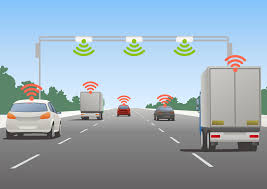Ghana presently has a standard tolling system for vehicle ranges. An empty cargo track would pay the same toll charge as a fully loaded truck. The essence of tolling is to help pay for road repairs and expansion. It is therefore appropriate to charge those vehicles that exert more weight on the road. A fully loaded truck from Tema Motorway should be made to pay more compared to an empty one. This can be easily addressed using scanners such as Light curtain laser profilers. There are also times when axil loads exceed the maximum allowable allowance. With the introduction of Sensor systems in the Electronic Tolling Collections (ETC) architecture, Sensors can be embedded on the surface, roadside or overhead. Inductive sensors embedded in the road surface can determine the presence of a vehicle. According to Persad et al (2007) Treadles register a count of the number of axles as a vehicle passes over them and, with offset-treadle installations, also detect dual-tire vehicles. Toll charges can be configured to charge more with the increase of axles and tires a vehicle has.

Fig: Light curtain laser profilers used in Germany (Vitronic brochure, 2004)

Fig: Video Tolling
Cost and Benefit of ETC system
Everything technology comes with its own challenges, benefits and shortcomings. Firstly, there is the possibility of system breakdown from the outdoor units to the indoor units. There should be a monitoring system to check all units and send field teams to repair any broken down unit. The communication between the onsite units and the toll management unit should be on a protected microwave or fiber link. A single unprotected link can go down at any time and cause huge revenue loss to the state. There are specific and unavoidable costs associated with ETC systems. There are costs associated with the transformation of the manual toll system to an ETC system. This includes cost of installation of indoor and outdoor units as seen in the system architecture. There is a toll agency cost. From best practices elsewhere, it is advisable to outsource the running and maintenance of the system to a toll agency. Their payments form a percentage of the monies they collect. There is also a cost to the road user. This cost would depend on the type of system that Ghana would introduce. In some countries, the On board unites (OBU) are given out for free while others are to be purchased. Also, some countries operate the pre-paid system, whereby monies are deducted from a road users account whenever he/she uses the toll system. In such cases, one is expected to always have a minimum balance on his account or credit card.
One challenge that we might face from the onset would be political interference from actors of the state. Politicians might delay in passing the necessary laws or might not fund the project as expected as result of pressure from their constituents who might feel the system is over burdening financially. There is a possibility or perception that ETC can be used to trace the movement of persons. This is possible but has to be done ethically. Tracking should only be activated for defaulters of the system.
On the positive side, it is expected that ETC system would improve the speed and efficiency of traffic flow and as a result save commuters valuable travel time. Manual toll collections have the capacity of handling less than 350 vehicles per hour (vph), whilst ETC lanes can process over 1200 vph. With better flow of vehicles, there is less congestion on our highways and there is low fuel consumption resulting to less pollution to the atmosphere. Also, low consumption of fuel results in less import of crude and other petroleum products. This result in less foreign exchange being used for these transactions and finally resulting in strengthening of the Ghana Cedi. The government would also see an increase in revenue, reduced accidents and robbery and an effective and efficient use of our highways.
The Ghana structure
As a firm believer in ICT and a practitioner, it is my hope that Ghana would adopt and implement the Open Road Tolling (ORT) type of ETC where there are no narrow or broad lanes for drivers of vehicle to follow. The ORT system has the ETC outdoor units installed on the lanes to capture traffic coming towards it. There are several levels of CCTV cameras that can be deployed to capture OBU’s, number plates, type of vehicle with additional support from scanners to verify the number of axles and the tire configurations for advanced charging. With ORT, there would be reduction in accident cases that arises due to drivers trying to move towards or away from towing lanes after or before payment of manual toll charges.
As I conclude the series on the call for the introduction of ETC, I call on the policy makers at the ministry of roads and highways and the Ghana Highway authority to look into introducing ETC in the shortest possible time to maximize revenue for the state, reduce the artificial traffic hold-up towards the toll booths, prevent the robbery that occur there and prevent the avoidable accidents at these areas.
Author: Samuel Hanson Hagan
(Member: Institute of ICT Professionals, Ghana; Telecommunication Consultant).
Email: shhagan@gmail.com
Mob: +233507393640





